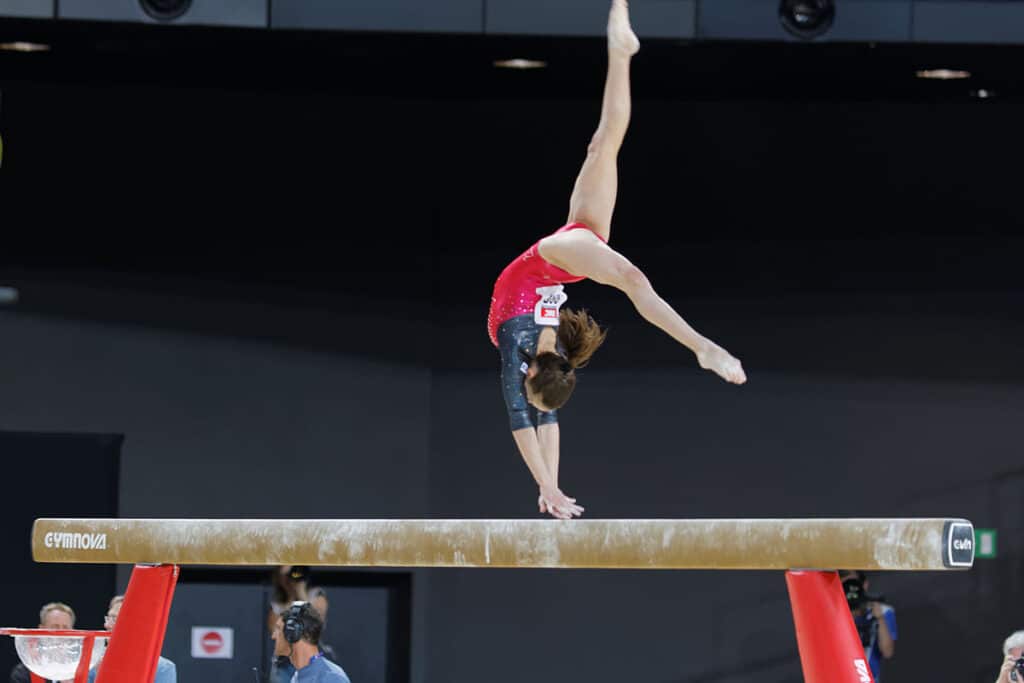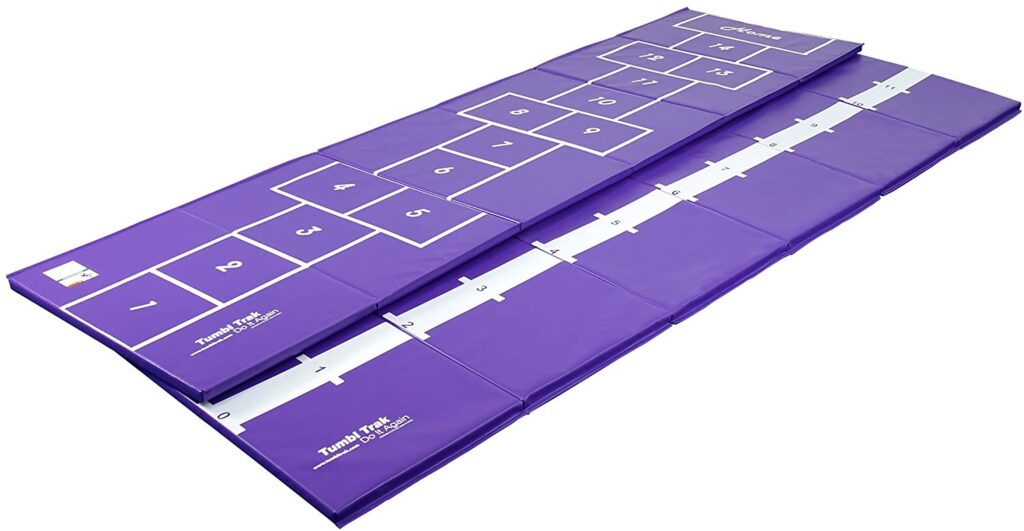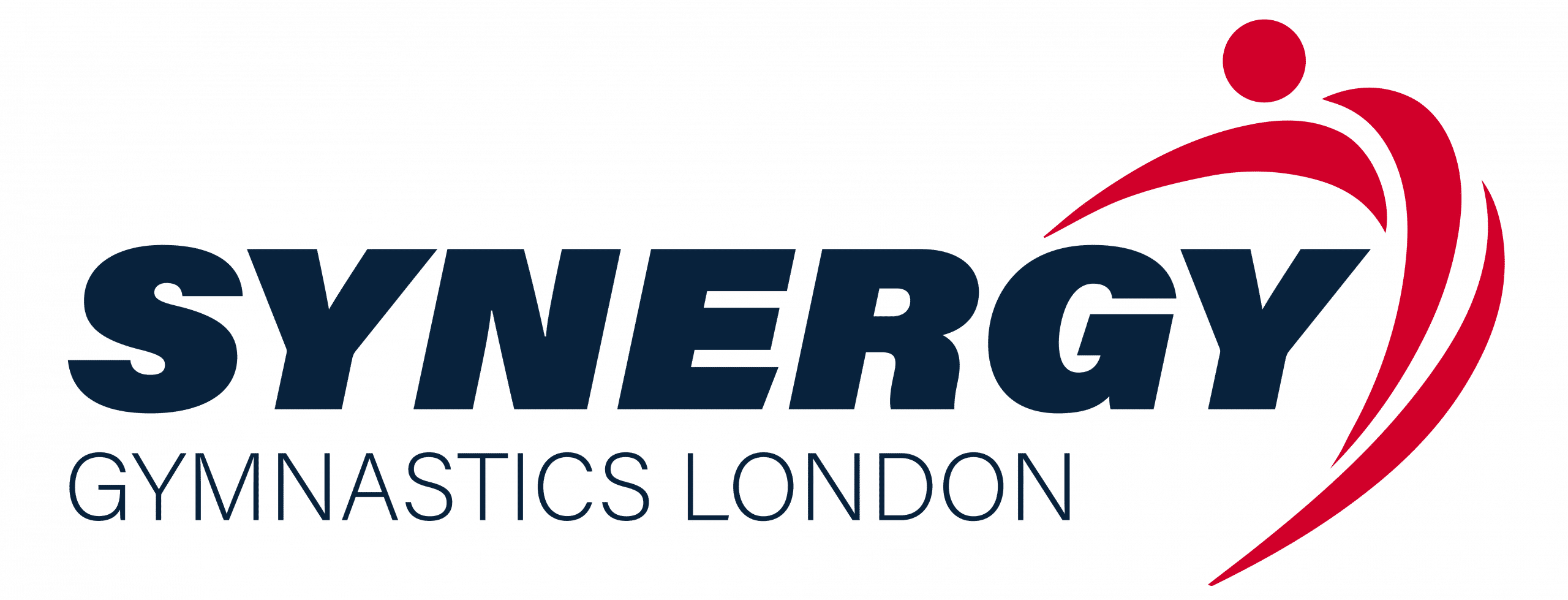
If you are just starting out in gymnastics you may be wondering what the ideal Balance Beam skills for beginners are. I have put together a list of the first skills I teach to beginners on the Balance Beam so that you can get started too.
These beginner balance beam skills are basic but will provide the stepping stones to learning more advanced skills in the future.
I always recommend seeking professional coaching when learning gymnastics so only practice at home if you feel safe and confident to do so.
Let’s get into this!
Disclaimer: Gymnastics carries an inherent level of risk. Information contained in this article does not replace the need for professional coaching in a recognized gymnastics facility.
#1 Walking: Forwards, Backwards, Sideways
The first way beginner gymnasts travel along the beam is by walking! It sounds simple but gymnasts must walk with good posture, style and control.
- Arms extended out to the side
- Head forward and chin up
- Back straight
Speed is not important but a gymnast should travel with rhythm instead. When walking sideways, the feet should not cross but when walking backward, the feet should cross just as they would when walking forward.
#2 Dip Walks
Once a gymnast can travel comfortably along the beam, they can start to work on their dip walks. As the name suggests, the gymnast needs to dip during each step.
All of the points about good posture need to be remembered and the foot should also stay pointed as it dips along the side of the beam.
Focus on keeping the back straight and eyes focused on the end of the beam as the dip down occurs. It is common for gymnasts to look down which in turn causes the chest to drop and balance to be lost.
#3 Travelling Rebound Jumps
As well as walking, gymnasts must be able to jump along the beam, keeping control and rhythm at the same time. Professional quality balance beams are designed to have some flex and rebound so as a gymnast lands there will be a little bounce. It’s nowhere near as bouncy as a sprung floor but it will be bouncier than a solid wooden beam which is usually very rigid.
To perform rebound jumps a gymnast makes a straight shape and bounces along the beam without bending the knees. More advanced gymnasts will combine different shapes such as tuck and straddle.
#4 Jump and Land: Straight, Tuck, Star, Half Turn
Beginner gymnasts on the beam must also master the landing of many different skills. The best place to start is with basic shape jumps that are performed on the spot. This means they should start and finish in the same place.
A good landing position will have:
- Bent legs
- Chest up
- Head forwards
- Arms extended
The landing position should be held for between 3 to 5 seconds. By mastering the basic shape jumps of straight, tuck, star and half turn a gymnast will be ready to move on to landing harder acrobatic skills and leaps.
These jumps can also be performed as dismounts from the end of the beam to land on the landing mat.
#5 One Leg Balance (Scale)
A one-leg balance on the beam should be held in a static position for at least 5 seconds. The balance can be changed by having the leg bent or straight and can be lifted to either the front, side or back.
A one-leg balance with the leg lifted behind is also known as the Arabesque.
A one-leg balance with the leg to the side can later be developed into the Y-Balance when the leg is lifted all the way above the head.
#6 Forward Roll
A forward roll on the beam is not an easy move but it is important for beginner gymnasts to start working on more acrobatic skills early on. I would highly recommend first learning forward rolls a low padded balance beam. It is very common for gymnasts to roll off-center and they will find it difficult to land the roll on the beam until they have tried it several times.
It’s also worth practicing on a line to reduce the risk of injury when rolling on a higher beam. Some panel mats and cartwheel mats have a straight line printed on the reverse so that gymnasts can get their hands and feet coordinated in a straight line. The Tumble Trak mat below is an example of a mat with a beamline. You can pick this one up for around $220 but there are cheaper versions available on Amazon.

Be sure to start the forward roll near the beginning of the beam so there is plenty of room to stand up at the end.
#7 Cartwheel Dismount
Being able to Cartwheel dismount from the beam is a milestone for many beginner gymnasts. It involves going upside down which can be daunting for younger gymnasts and it is easy to over-rotate as the extra air time is unusual.
As with so many other beam skills a gymnast has to master the cartwheel on the floor and on a line before attempting to move onto a higher beam. I encourage gymnasts to land with a quarter turn-in (finish facing the beam) as they can then keep their eyes focused on the end of the beam throughout. This will also help with spatial awareness and landing with control.
Balance Beam Routine for Beginners
Once a gymnast has mastered most of these skills they will be ready to perform them in a routine. Competitive gymnasts on beam have to include at least 8 skills in their routine and link them with dance and movement that flows smoothly. Here is an example of a balance beam routine for a beginner:
- Start in a standing position at one end of the beam.
- Three steps forward
- One leg balance (hold 5 seconds)
- Straight Jump
- Quarter turn jump
- Three side steps
- Star Jump
- Quarter turn jump
- Three dip walks forwards
- Cartwheel dismount
Tip: Have great posture throughout including pointing the toes and keeping the head forwards.
Final Thoughts
These balance beam skills for beginners help lay the foundations to become really confident on the beam. You should always seek professional guidance when taking part in gymnastics and take care when attempting a skill for the first time.
If you want to find out more about the balance beam in gymnastics check out my in-depth guide. I have also written a review on which balance beams are great for home use.
